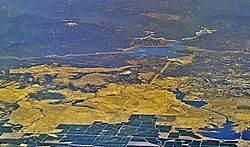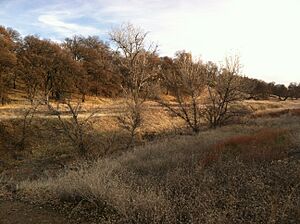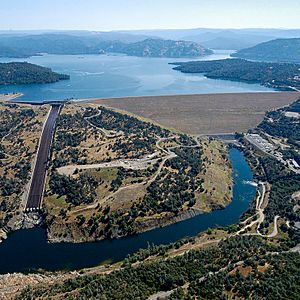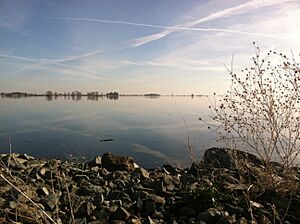Oroville–Thermalito Complex facts for kids
Quick facts for kids Oroville–Thermalito Complex |
|
|---|---|

Aerial view from the west showing Lake Oroville, the Oroville Dam, Thermalito Forebay and Thermalito Afterbay
|
|
| Location | |
| State | California |
| Region | Northern California |
| County | Butte |
| Nearest City(s) | Oroville East, Ca, Oroville, Ca & Thermalito, Ca |
| Operations | |
| Operator | California Department of Water Resources (DWR) |
| Other operators/co-operators | Feather River Recreation and Parks District (FRRPD), California Department of Fish and Game |
| Sources | |
| Primary source | Lake Oroville |
| Other source(s) | Feather River |
| Construction & operations | |
| Designed & built by | United States Army Corps of Engineers |
| Construction period | 1961-1969 |
| Operations began | 1968 |
The Oroville–Thermalito Complex is a huge system of lakes, dams, and power plants. It is found near the city of Oroville in Butte County, California. This complex is super important for storing and moving water. It also helps power the State Water Project, which is one of the biggest water and power systems in the world!
What is the Oroville–Thermalito Complex?
The Oroville–Thermalito Complex was built to store water and create electricity efficiently. All the lakes and canals in the complex can hold a massive amount of water. This is about 3.6 million acre-feet, which is like 1.15 trillion gallons!
The complex also makes electricity using power plants like the Hyatt Powerplant. A special dam was even built to help salmon and steelhead fish find their way to the Feather River Fish Hatchery.
Water released from Lake Oroville flows through the Hyatt Powerplant. This plant is located deep inside the Oroville Dam. The water can then go into the Feather River or be sent into the Thermalito Power Canal. From there, it moves through other parts of the complex to make even more electricity.
Main Parts of the Complex
Lake Oroville
39°33′22″N 121°27′06″W / 39.55611°N 121.45167°W Lake Oroville is the second largest lake in California. It collects water from winter and spring rains and snowmelt. This water is then slowly released into the Feather River when it's needed.
The lake also helps control floods, provides fun recreation spots, and releases fresh water to protect fish and wildlife. It's the starting point for the entire State Water Project. Lake Oroville can hold over 3.5 million acre-feet of water. It has a surface area of about 15,810 acres and 167 miles of shoreline.
Oroville Dam and Spillway
39°32′15″N 121°29′01″W / 39.53750°N 121.48361°W
The Oroville Dam is the tallest and largest dam in the United States. It was finished in 1968. The dam stands 770 feet high and is 6,920 feet long across its top.
Building the Oroville Dam took over 80 million cubic yards of material. That's enough material to build a two-lane highway all the way around the Earth! The California Society of Professional Engineers even called it one of the "seven wonders of engineering" in California.
Inside the dam is a thin layer of clay that stops water from leaking through. The rest of the dam is made from sand and gravel left over from gold mining in the early 1900s. Beneath the dam, there's a huge underground cavern. It's almost as big as the State Capitol Building! This cavern holds six power generators. These, along with four more at the Thermalito Pumping–Generating Plant, create a lot of electricity every year.
Edward Hyatt Powerplant
39°32′01″N 121°29′07″W / 39.53361°N 121.48528°W The Edward Hyatt Powerplant is an underground power station located near the Oroville Dam. It was built between 1964 and 1967.
This plant is special because it can both generate electricity and pump water back into Lake Oroville. When there's extra water, it's pumped back up. Then, when electricity is needed most, the water is released again to make power. This helps save energy and make the most of the water.
The plant was named after Edward Hyatt, who was a State Engineer for many years. He worked for the department that came before the Department of Water Resources.
Thermalito Diversion Pool
39°32′33″N 121°32′37″W / 39.54250°N 121.54361°W The Thermalito Diversion Pool works with the Diversion Dam. It creates a calm pool of water for the Hyatt Powerplant, which is just around the bend. This pool also acts as a holding area when the Hyatt Powerplant pumps water back into Lake Oroville. It's also a great spot for recreation!
Thermalito Diversion Dam
39°31′43″N 121°32′41″W / 39.52861°N 121.54472°W The Thermalito Diversion dam is at the south end of the Diversion Pool. It can send water in two directions. It can send water west into the Thermalito Power Canal to make electricity. Or, it can release water straight south into the Feather River. The Diversion Dam is 143 feet tall and 1,300 feet long.
Thermalito Diversion Dam Powerplant
39°31′44″N 121°32′48″W / 39.52889°N 121.54667°W This power plant is located at the Thermalito Diversion Dam. It makes electricity from water that is released into the Feather River. This water helps keep a good environment for fish. It was built between 1985 and 1987. The plant has one generator and can produce 3.3 megawatts of power.
Thermalito Power Canal
39°31′52″N 121°33′55″W / 39.53111°N 121.56528°W The Thermalito Power Canal is a 10,000-foot-long concrete canal. It connects the Thermalito Diversion Dam to the Thermalito Forebay. Water can flow both ways in this canal. This allows water to be pumped or used for power generation at different plants. Construction on the canal happened between 1965 and 1967.
Thermalito Forebay
39°28′12″N 121°40′30″W / 39.47000°N 121.67500°W The Thermalito Forebay is a reservoir located about four miles west of Oroville. It helps move water for power generation and pumping. It also helps control water surges from the power complex. Plus, it's a popular spot for recreational activities! The Forebay can hold about 11,770 acre-feet of water and has a shoreline of 10 miles. It was built between 1965 and 1968.
Thermalito Pumping–Generating Plant
39°30′55″N 121°37′45″W / 39.51528°N 121.62917°W This plant is a key part of the Oroville–Thermalito power system. It works with the other power plants to make electricity. Like the Hyatt Powerplant, it can also pump water back into Lake Oroville. This saves water to be used again for power when demand is high.
The plant has four units and can generate 120 megawatts of power. It was built from 1964 to 1969. In 2011, it was renamed the Ronald B. Robie Thermalito Power Plant.
Thermalito Afterbay
39°30′55″N 121°37′45″W / 39.51528°N 121.62917°W The Thermalito Afterbay is much larger than the Forebay. It's connected to the Forebay by a 9,100-foot-long canal. The Afterbay stores water needed for pumping back to Lake Oroville. It also helps control the power system and water flow in the Feather River.
This area is also used for recreation. It even acts as a warming basin for water used to irrigate nearby rice and grain fields. The Afterbay can hold over 57,040 acre-feet of water and has a shoreline of 26 miles. The Thermalito Afterbay Dam is 42,000 feet long, making it the longest dam crest in the State Water Project! Construction on the Afterbay took place from 1965 to 1968.
Fish-Barrier Dam
39°31′13″N 121°32′51″W / 39.52028°N 121.54750°W This dam is right next to the Feather River Fish Hatchery. Its job is to guide fish away from the main river and into a fish ladder that leads to the hatchery. This helps fish like salmon get to a safe place to lay their eggs. The barrier dam is 91 feet tall and 600 feet long. It was built between 1962 and 1964.
Feather River Fish Hatchery
39°31′04″N 121°33′15″W / 39.51778°N 121.55417°W The Feather River Fish Hatchery was built because the Oroville Dam blocked the natural spawning grounds for salmon and Steelhead trout. At the hatchery, salmon and steelhead are raised in special tanks. Then, they are released into the Feather and Sacramento Rivers, Lake Oroville, and the Delta near the San Francisco Bay area.
These fish are very important! They make up about 20 percent of the ocean sport and commercial fish caught in the Pacific Ocean. The hatchery first welcomed fish in 1967. Today, it can hold about 8,000 fish. The Feather River Fish Hatchery was built between 1966 and 1967.
Images for kids





